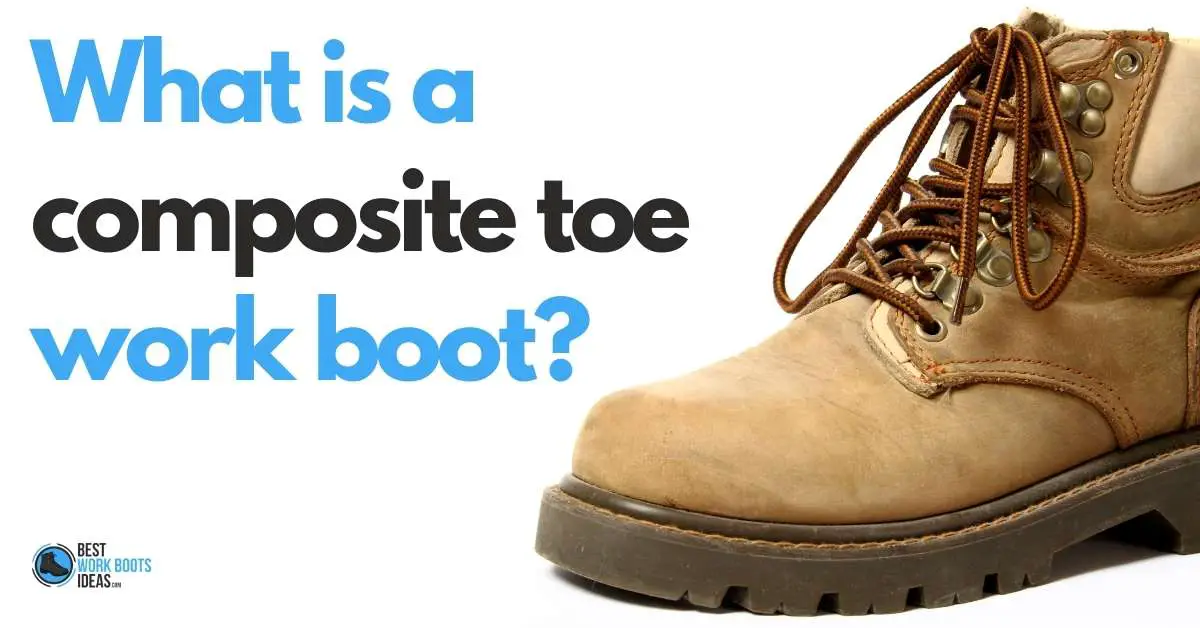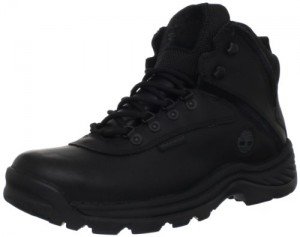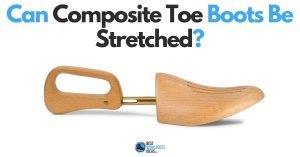What is a Composite Toe Boot? Your Complete FREE Guide and Questions Answered

When buying your next pair of work boots you might see many advertised as ‘composite toe boots.’
It’s important to know what that means and that’s what I’ll cover in this article.
I worked for years in construction and wearing work boots was a daily occurrence.
I’ve worn composite toe boots, steel toe boots, and boots with no toe cap at all (I discourage anyone from making this choice).
Based on my experiences, I’m going to explain what a composite toe work boot does and how it compares to boots you may be familiar with.
With that, let’s get into the details about composite toe protection in safety footwear.
Contents
What is the definition of a Composite Toe Work Boot?
A composite toe boot is a work boot (safety boot) that has a toe cap made of a composite material. The material can be made of any number of things, but it is not made of any sort of metal.
There are a number of benefits and a few down sides that come with composite toe boots. Some might be obvious, some less-so; we’ll get into all of them.
Safety Features of Composite Toe Boots
Composite toe boots are capable of meeting the same ASTM standards as steel or alloy toe caps.
This is the primary aspect to consider with composite toe boots, whether or not they meet OSHA requirements.
In some cases, but certainly not all cases, composite materials may not be as strong as steel or alloys.
You might also be interested to know how much weight a composite toe can hold. You should definitely read that.
Please check the “What materials…” subheading further down to learn more.
That said, a composite toe cap is designed to meet the same standards (ASTM F2413) you expect from traditional steel, and will absolutely protect your toes.
Some people might be wondering why they ever would want a weaker material, but I’ll frame it in a different way.
Paper is weaker than metal, but there are many bullets that will be stopped by a phone book that will go right through a car door.
It’s not always about the material, but how it is applied that makes the difference.
Composite Toe Boots are Lighter
The most notable difference of composite toe caps is their lighter weight. Composite toe caps are lighter than the alternative steel or alloy toe caps.
The old idea that heavy is more durable is not necessarily true.
What is true is that boots that are toe-heavy (imbalanced) can cause shin splints and irregular muscle development to compensate for the shin pain the wearer experiences.
There is the argument that the toe cap doesn’t account for much weight in the boots, but consider how many times you lift your legs during a work day.
Any bit of difference multiplied by tens of thousands is going to be a substantial increase, or decrease, depending on whether you go lighter or heavier.
The average range for composite boots weight goes lower than steel, and doesn’t reach as high as steel, but even in the most conservative estimations you could still cut a couple ounces from the stress on your legs.
In some instances you might be able to drop a couple pounds!
Composite Toe Boots Protect Against Electrical Hazards
Composite toe boots have the added benefit of being non-conductive to electricity.
This is one of those points that goes without saying, it’s more of a friendly reminder, metal conducts electricity non-metals don’t.
There are some that forget this point. I encourage them to pinch a sheet of plastic, and then a paperclip on both sides of a AA battery; let me know if there’s a difference in how your fingers feel.
Hypothetically speaking of course, please don’t actually try this.
Most of us don’t consider that when we’re walking around with a steel or alloy toe boot, we’re increasing the chance of catching an electrical current. “How would I accidentally come in contact with electric currents? My work doesn’t involve that.”
Yeah, neither did mine, but I remember numerous times where to my surprise, there was suddenly an electrical wire I was happy not to have stepped on, drilled, or sliced with a shovel.
On the average day, the odds are very low that you’ll get injured, yet hundreds of thousands of workers get injured every year!
Work safety is all about fractional reductions of probability. When you combine a number of safety features that reduce your chance of being injured, you’ve become the person on the job that stays on the job.
Composite Toe Boots Don’t Conduct Temperature
Composite toe boots will not conduct temperature as steel and alloy toes will.
The composite materials do not react to temperature, either hot or cold, so they will not amplify whatever weather is occurring on the outside.
This is something that would probably not be considered by a new worker, but veterans who have spent a winter working outside can tell you that your toes can get dangerously and painfully cold.
Even if the rest of your foot is perfectly comfortable, having your toes spend the entire day next to a natural refrigerator is going to make for an unpleasant day at work.
Composite Toe Boots Don’t Set Off Metal Detectors
An added benefit for some workers is that composite toe boots will not set off metal detectors.
I understand that many reading this are wondering why that would matter, while a smaller percentage are jumping for joy at the idea of not needing to take their boots off upon entering work, or coming back in from break, or lunch, or on a material run.
For anyone that works at locations with metal detectors, I can’t recommend composite toe boots highly enough.
Having worked residential construction for a number of years, I encountered some homeowners that asked us to remove our shoes upon entering their homes.
While this was absolutely their right, I can say that it reduced our productivity by quite a bit.
If there was any sort of feature I could have purchased to eliminate the need for this, I would have.
No technology to avoid mud though!
What Materials are Composite Toe Caps Made of?
Plastic
Toe caps made of plastic are every bit as reliable as their metal competition.
Cheap, moldable, and reliable, plastics have been a staple of pretty much every industry that exists since their development.
Kevlar
Resistant to temperature, flexible and incredibly strong, Kevlar is an ideal material for toe caps.
Kevlar might not have been the material you considered when trying to protect your toes, but it does just as good a job of that as stopping bullets or blades.
Kevlar falls under the category of plastics, but is a brand name that has recognition all on its own for safety and reliability.
10x stronger than steel, it’s simply aramid fibers wound so tightly that almost nothing can pierce or break them.
Carbon Fiber
Carbon fiber toe caps are arguably the best material in the business.
Lighter, stronger, and less bulky than steel, this material gives workers the whole package when they’re looking for a boot that keeps them safe while allowing for peak performance at the same time.
Carbon fibers were first discovered by none other than Thomas Edison, but didn’t come into widespread usage until the latter parts of the 20th century.
It was only at this point that new manufacturing techniques allowed carbon fiber’s true potential to become fully unlocked.
Fiberglass
Fiberglass is not a new material but it’s tried and true. It’s extremely light (55g-65g) and it can be made thinner than other plastic materials.
The downside of fiberglass toe caps are that they tend to be a bit pricier and if they absorb a substantial impact, they dent.
Unlike a surfboard or boat hull, there’s no repairing them and you’ll need to get a new pair of boots if you want to keep your toes protected in the future.
Other Things To Consider
There are a couple of drawbacks to composite toe boots, so allow me to cover them so you have the full picture
Bulkiness
The average composite toe boot is going to be a bit bulkier in the toe.
Being that most composite toes will be made of plastic and not an advanced material like Kevlar or carbon fiber, they need to create larger toe caps in order to provide the same protection as steel or alloys.
This is a problem that can be easily rectified by seeking out a composite toe boot that uses one of those advanced materials so you can get all the protection without any extra bulkiness.
Cost
Again, the average composite toe boot is going to run you a little more than its metallic competition.
The importance of this comes down to whether you’re interested in lighter boots that will tire your legs less, or saving some money at checkout.
Each person is different, but it’s good to know that if you’re looking for composite toe boots, it’s probably going to run you a little bit more.
Wrapping Up…
I hope this has been useful as you look into a new pair of protective footwear, or just want to understand the gear a little bit better.
Composite toe boots are already the cutting edge technology, and seem to dominate the future of the industry.
It will be exciting to see how the technology and construction methods advance even further in the coming years.
You might also be interested in comparing Alloy Toe vs Steel Toe vs Composite Toe.
Also, don’t forget to ensure you always have the correct personal protective equipment (PPE) when it comes to composite toe shoes.




![how to break in steel toe boots [featured image]](https://www.bestworkbootsideas.com/wp-content/uploads/2023/07/how-to-break-in-steel-toe-boots-featured-image-300x157.jpg)

